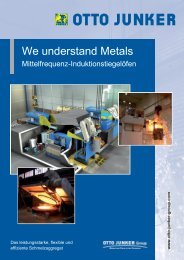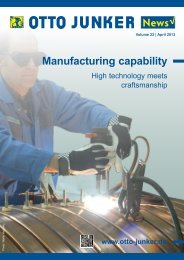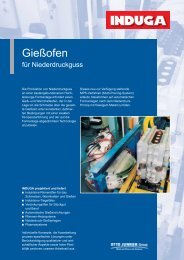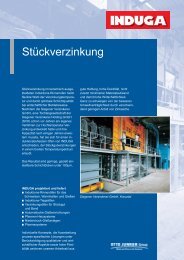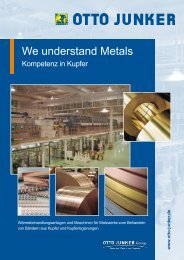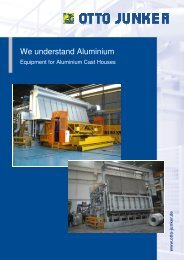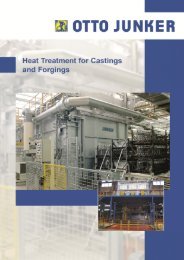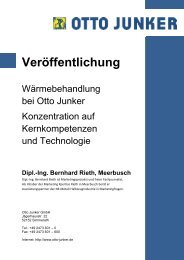Billet homogenising _batch or continuous - Otto Junker GmbH
Billet homogenising _batch or continuous - Otto Junker GmbH
Billet homogenising _batch or continuous - Otto Junker GmbH
You also want an ePaper? Increase the reach of your titles
YUMPU automatically turns print PDFs into web optimized ePapers that Google loves.
7 / 11<br />
Fig. 5: CFD simulation of a possible nozzle array f<strong>or</strong> the heat-up zone of a <strong>continuous</strong> homogenizing<br />
furnace acc<strong>or</strong>ding to the Nozzle-flow concept (left), compared with the Mass-flow concept (right)<br />
With a stack as illustrated in Fig. 4 in a <strong>batch</strong>-type homogenizing plant, using the nozzle-flow<br />
concept would achieve high local heat transfer only to the positionally fixed, outermost<br />
aluminium logs. Since the high incident flow speed cannot be maintained along the path<br />
through the stacked charge, the convective heat transfer is reduced and the already<br />
mentioned temperature differences relative to the also positionally fixed inner aluminium logs<br />
would be produced. F<strong>or</strong> that reason the mass-flow concept, with a lower flow speed (< 10<br />
m/s) but one that is m<strong>or</strong>e constant relative to the aluminium logs, is to be preferred. The<br />
homogenizing of aluminium logs demands a close temperature tolerance of ± 5 K <strong>or</strong> better.<br />
The temperature difference produced during heating is the smaller, the less is the<br />
temperature change of the circulating furnace atmosphere (fluid) relative to the temperature<br />
change of the furnace charge. This ratio, the so-termed ‘capacity flow ratio’, is expressed by<br />
the following relationship:<br />
The capacity flow ratio should always be as large as possible, but there are economic limits<br />
on this: increasing the capacity flow ratio requires an increase of the flow impingement<br />
speed. Whereas the convective energy flow increases approximately acc<strong>or</strong>ding to α ~ V0.8,<br />
the power up-take of the fans increases acc<strong>or</strong>ding to PFan ~ V3 so that doubling the flow<br />
impingement speed, which achieves a convective energy flow increase of only about 75%,<br />
entails an eightfold increase of the fan power. Thus, the eff<strong>or</strong>t (e. g. structural space,<br />
operating costs) and benefit (heating time, temperature tolerance) always have to be<br />
weighed against one another. In practice it has been found appropriate in homogenizing<br />
furnaces, with both the nozzle-flow and mass-flow concepts, to adjust the capacity flow ratio<br />
to the maximum value that can be obtained economically. The convective energy flow, and in<br />
addition the fraction transferred by heat radiation to the surface of the aluminium logs, must<br />
OTTO JUNKER <strong>GmbH</strong><br />
Jägerhausstraße 22<br />
52152 Simmerath<br />
Tel.: +49 2473 601-0<br />
Fax: +49 2473 601-600<br />
Internet: www.otto-junker.de<br />
K<br />
=<br />
(<br />
m ⋅c<br />
n<br />
.<br />
( ∑mi<br />
c<br />
i=<br />
1<br />
.<br />
p<br />
)<br />
Fluid<br />
p,<br />
i<br />
)<br />
Gut<br />
Anlagenbau<br />
Gießerei



